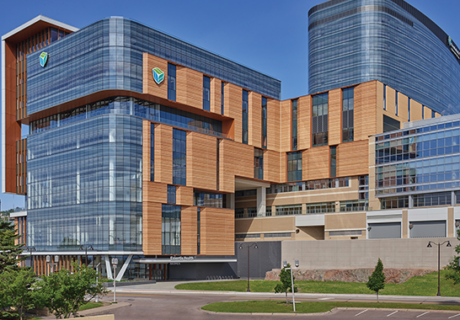Conversion Story: Reconfiguring A Decommissioned Facility Into An Alternate Care Site
With only four weeks to convert a vacant medical office building into an alternate care facility (ACF), a project on the site of the former Advocate Sherman Hospital Center Street campus in Elgin, Ill., was the challenge of a lifetime. In March, Perkins&Will’s healthcare team (Chicago), along with design-build partner Turner Construction (Chicago) and MEP partner Salas O’Brien (Chicago), responded to a U.S. Army Corps of Engineers (USACE) solicitation to transform the shuttered medical facility on the Elgin campus into an ACF for COVID-19 patients (the former hospital on the site had been torn down several years ago).
After the request for proposals was released on a Friday night, the team’s proposal was submitted and awarded by Sunday evening and everyone was on-site Monday morning. The highly collaborative effort, which involved more than 200 architects, engineers, contractors, and construction workers, provides lessons for future projects.
Walking the vacant facility the first day, the project team found abandoned medical supplies, old equipment, and discarded furniture along with the aging conditions of an unoccupied medical office building. Few existing rooms were deemed suitable for patient use.
Extreme time constraints were another issue, with construction that had to occur in parallel with design, as well as the overall pressure of confronting a global pandemic, meaning critical-path decisions needed to be made quickly. This was accomplished by focusing on understanding and communicating the latest information in a constantly evolving situation; engaging the right people from all parties and being accessible for critical sign-offs at the right time; and making a decision when it needed to be made.
To get from project kickoff to setting the guaranteed maximum price in six days, the team collectively assessed the building conditions, defined project objectives, and set quality expectations at the start. This was achievable because key individuals from USACE, the Illinois Department of Public Health (IDPH), Turner, Perkins&Will, Salas O’Brien, and trade partners were mobilized, on-site, and engaged from the beginning to simultaneously assess challenges from multiple fronts in a highly collaborative environment.
The team quickly identified areas that weren’t practical for patient beds and determined that extensive interior demolition of one wing of the building would be the most effective way to maximize the bed count. The result was a negative air pressurized wing of COVID-19 patient wards, with each patient bay outfitted with a wireless nurse call system and supervised by nurses’ stations spaced throughout the wards.
Determining how many beds could be achieved and where to locate them required an understanding of the requirements of an ACF and rapid evaluation of existing conditions. The Centers for Disease Control and Prevention’s Considerations for Alternate Care Sites provided direction for critical infection prevention within non-traditional environments. These guidelines supplemented the pandemic planning guidelines that the IDPH level of care requirements outlined.
With guidelines in place, the project team determined 274 beds could be achieved. Additionally, the planning process focused on defining the patient bay size, identifying major building circulation, segregating flows of staff and differing levels of COVID-19 infected patients, meeting support space requirements, and solving infrastructure needs such as handwashing facilities, negative air pressure zones, and nurse call systems within the existing building.
Driven by the urgent need to rapidly deliver the ACF, the project team set aside conventional processes, documentation methods, roles, and priorities to deliver solutions quickly. For example, traditional silos separating the design team, contractor, and client were removed to eradicate waste from the process and communication paths were forged with an emphasis on trust.
By embracing the mission-driven mindset of the USACE, the team successfully delivered the project one day ahead of schedule. Not all projects require this level of shared sacrifice and personal risk but achieving solidarity across an entire team should be a part of every project’s mission.
Jennifer Riddle Curley, AIA, LEED AP, is a senior associate at Perkins&Will (Chicago). She can be reached at Jennifer.RiddleCurley@perkinswill.com.






